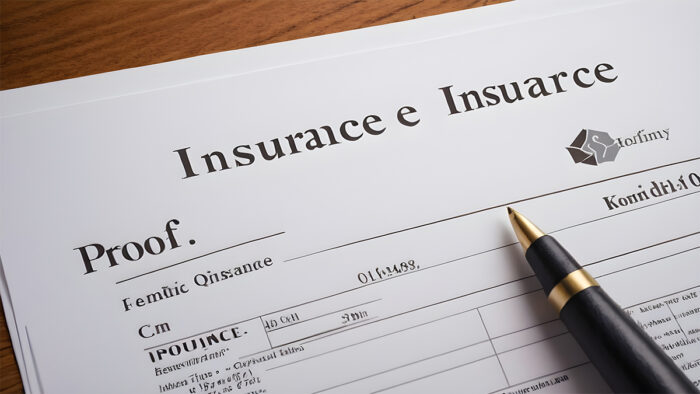Proof of insurance (POI) is a document or piece of evidence that demonstrates an individual or entity has active insurance coverage for a particular risk or liability. It typically includes details such as the policyholder’s name, policy number, effective dates of coverage, and the types of coverage provided. Various situations often require this proof, such as registering a vehicle, obtaining a driver’s license, or filing an insurance claim.

How to Show Proof of Insurance
To show POI, you can follow these steps:
- Obtain Your Insurance Card: Contact your insurance company to request a faxed insurance card to your desired location, such as your home, office, or DMV.
- Use a Printed Card or Electronic Version: You can display your proof of insurance on a printed card from your insurer or an electronic version from their mobile app or website. Ensure it includes essential details like the insurance company’s name and address, policy number, effective dates, and vehicle information.
- Keep It Accessible: Before hitting the road, make sure you have your driver’s license, vehicle registration, and proof of insurance in your car. Most states mandate a minimum auto insurance requirement, and your proof of insurance demonstrates compliance with these regulations.
- Digital Proof of Insurance: In most states, you can use electronic proof of insurance on your phone, except in New Mexico. It’s advisable to have a physical card as a backup in case electronic proof is not accepted.
- Show Proof When Necessary: You may need to present proof of insurance when registering a vehicle, renewing a license, in accidents, or when stopped by law enforcement. It serves as evidence that you have an active and valid auto insurance policy meeting state requirements.
Ensure compliance with legal mandates and prepare for various driving situations by following these steps and having your proof of insurance readily available in either physical or electronic form.
What Details Does Proof of Insurance Offer?
The majority of insurance providers typically include essential details on an insurance identification card. This information includes:
- Name and address of the insurance company
- The policy’s effective start and end dates
- Policy number and National Association of Insurance Commissioners (NAIC) number
- First and last name of the policyholder
- Year, make, model, and Vehicle Identification Number (VIN) of the insured vehicle
Proof of insurance signifies that you possess at least the minimum coverage mandated by the state. However, this documentation generally does not specify the precise types of coverage (e.g., collision, comprehensive) or the policy limits.
How to Acquire Proof of Insurance
Upon purchasing a policy, your insurance provider will furnish you with proof of insurance. Following your initial premium payment, some insurance companies offer immediate proof of insurance through fax or email.
Furthermore, you may receive this documentation electronically. Notably, 49 states and the District of Columbia permit drivers to present a digital version of their insurance card. New Mexico is the only state that may not accept electronic proof.
If you do not receive your proof of insurance, it is advisable to contact your insurance company promptly to obtain the necessary documentation.
Why Do You Need Proof of Insurance?
Proof of insurance is a critical document that serves multiple purposes, primarily as a legal requirement in most states. It demonstrates compliance with state laws mandating a minimum auto insurance coverage, ensuring that drivers have the financial means to cover damages or injuries they may cause in an accident.
Beyond legal obligations, it provides a layer of financial protection in the event of an accident, confirming that the driver has coverage to mitigate potential losses. Additionally, having a valid POI helps drivers avoid penalties such as fines, license suspensions, or increased insurance premiums resulting from coverage lapses.
Moreover, it offers convenience by serving as a quick and accessible way to verify insurance status during various situations, like traffic stops or vehicle registration processes. Overall, it is not just a piece of paper; it is a fundamental tool that safeguards drivers, ensures compliance with regulations, and provides peace of mind on the road.
What is SR-22 insurance?
Certain states may require individuals to possess an SR-22 certificate, which an insurance provider submits to the state as proof of possessing the necessary level of liability coverage.
The circumstances that typically necessitate obtaining an SR-22 certificate include:
- Being convicted of driving under the influence or driving while intoxicated.
- Accumulating serious and repeated traffic violations.
- Involvement in at-fault accidents without insurance coverage.
- Having a suspended or revoked driver’s license.
Obtaining an SR-22 is not usually costly, with fees typically around $25, varying based on location and insurance company. However, individuals may experience significant increases in their auto insurance premiums due to the underlying reasons for requiring an SR-22, such as a DUI conviction.
Generally, states require drivers holding an SR-22 to maintain it for a minimum of three years, although the specific duration may differ. It is important to note that the SR-22 may not automatically be removed from the policy at the end of this period.
If you have fulfilled your obligations and the SR-22 remains on your policy, it is advisable to contact your insurance provider to request its removal along with any associated fees.
What If You Can’t Show Your Proof of Insurance?
If you are unable to show POI, it can lead to various consequences, depending on the state’s regulations. In most states, driving without proof of insurance can result in fines, license suspensions, or even jail time.
If you receive a ticket for not providing proof of insurance, you may contest it by mailing a copy of it or attending a court hearing with the necessary documentation. While charges could potentially be dismissed, fines or court fees might still apply.
It is crucial to respond to all correspondence related to the issue promptly, as some states may revoke or suspend your license and vehicle registrations if you fail to prove you are insured. Many states utilize electronic insurance verification systems to identify uninsured drivers, which can lead to administrative actions if discrepancies are found between vehicle registration and insurance information.
Therefore, it is essential to ensure you have valid proof of insurance readily available to avoid legal repercussions and maintain compliance with state requirements.
FAQs
Can you show electronic proof of insurance?
In most states, you can legally show electronic POI on your phone, except in New Mexico. However, it’s advisable to have a physical card as a backup in case they do not accept electronic proof.
What does proof of insurance look like?
It commonly appears as a small card with details such as policy number, policy term, driver’s name, insurer’s name, and vehicle information. It can also be in the form of a printout or shown through an app or website.
What to Do If You Lose Your Insurance Card?
If you misplace your insurance card, options include downloading the insurance company’s app for digital copies, accessing your account online to print out a card, or contacting your agent for assistance.



